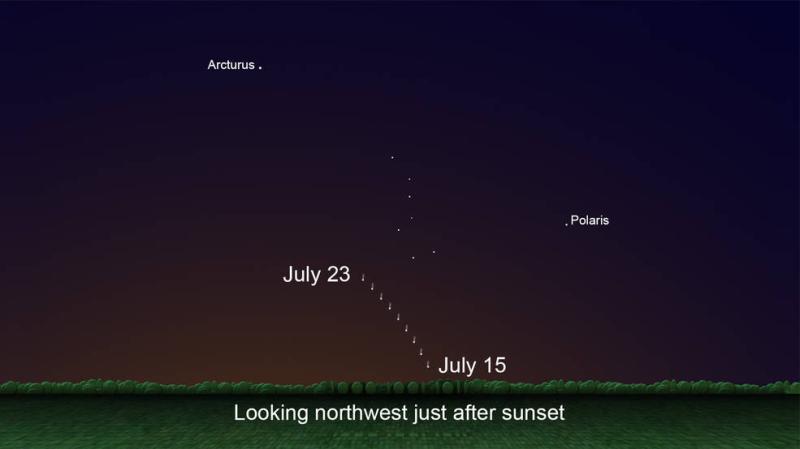How to See Comet NEOWISE



How to See Comet NEOWISE
Observers in the Northern Hemisphere are hoping to catch a glimpse of Comet NEOWISE as it zips through the inner solar system before it speeds away into the depths of space. Discovered on March 27, 2020 by NASA’s Near-Earth Object Wide-field Infrared Survey Explorer (NEOWISE) mission, Comet NEOWISE is putting on a dazzling display for skywatchers before it disappears, not to be seen again for another 6,800 years.
For those hoping to catch a glimpse of Comet NEOWISE before it’s gone, there are several observing opportunities over the coming days when it will become increasingly visible shortly after sunset in the northwest sky. If you’re looking at the sky without the help of observation tools, Comet NEOWISE will likely look like a fuzzy star with a bit of a tail, so using binoculars or a small telescope is recommended to get the best views of this object.
For those hoping to see Comet Neowise for themselves, here’s what to do:
-
Find a spot away from city lights with an unobstructed view of the sky
-
Just after sunset, look below the Big Dipper in the northwest sky
-
If you have them, bring binoculars or a small telescope to get the best views of this dazzling display
Each night, the comet will continue rising increasingly higher above the northwestern horizon as illustrated in the below graphic:

Skychart showing the location of Comet C/2020 F3 just after sunset, July 15 through 23.
Credits: NASA/JPL-Caltech
Want to learn more about Comet NEOWISE? Take a look at some of these resources:
Read these skywatching Tips from NASA: https://solarsystem.nasa.gov/whats-up-skywatching-tips-from-nasa/
Learn these tips and trick on how to photograph comets and meteor showers: https://solarsystem.nasa.gov/news/510/how-to-photograph-a-meteor-shower/
Take a look at these images of Comet NEOWISE captured by NASA missions:
-
Parker Solar Probe: /feature/goddard/2020/nasa-s-parker-solar-probe-spies-newly-discovered-comet-neowise
-
International Space Station: /image-feature/comet-neowise-from-the-international-space-station and /image-feature/comet-neowise
-
ESA and NASA’s Solar and Heliospheric Observatory: https://svs.gsfc.nasa.gov/13661
Explore various comet lessons and activities for educators and students:
Learn more about NASA’s (NEOWISE) mission that discovered Comet NEOWISE: https://www.nasa.gov/feature/jpl/comet-neowise-sizzles-as-it-slides-by-the-sun-providing-a-treat-for-observers
Brush up on comet science and learn how NASA studies these celestial objects: https://solarsystem.nasa.gov/asteroids-comets-and-meteors/comets/overview
Learn more about comet science, how Comet NEOWISE was discovered, and how you can spot it in the sky in this episode of NASA Science Live:



Here's a link to an MSN slideshow of the comet from various places around the world:
Spectacular Views of Comet Neowise
Nice! Thanks, 👍
Has anyone spotted it yet? I had clouds tonight.
My cabin is the perfect viewing spot but I have it rented until next Tuesday. How long will it be viewable?
Not sure, but the graphic above shows positions through July 23, so at least that long.
Be warned, I seen it last night around 10:30, it is very faint, I even looked for it a 2 am hoping for the darkest possible sky and it still took my night vision binoculars to find it almost straight north, after locating it I could barely see it by naked eye.
Yeah, the articles I've read about it all suggest using binoculars.
Crazy part about this is that it was just discovered this March
Might have to take a drive. I have a mountain to the northwest.
I saw this amazing photo on the CTV (Canada TV News) website:
Comet NEOWISE is seen streaking above the sky with the Aurora Borealis visible just outside of Vancouver on July 13. (Liron Gertsman / @liron_gertsman_photography)
Gorgeous!
That's amazing.
I keep forgetting to look. Don't know if I can see it from my house if it is low in the sky. Would probably have to hit the beach.
It's visible here in Michigan between the 44th & 45th parallel, right now it's halfway from the lip of the big dipper to the horizon. I still needed to use the night vision binoculars to find it, but after that I can locate it visually.
Yeah I caught it last night the same way. Tough to find with the naked eye unless you’re in a real low ambient light area.
Thinking about it the further south it may be brighter, being this far north I noticed that there were satellites going over to the north which means the earth's shadow is very shallow here and the upper atmosphere may still be receiving light from the summer sun washing out the comet.
Yeah, the space station is like a moving spotlight when viewed with night vision near dusk. Very bright.
Clouds one night and haze the next, but I finally got to see it tonight. It was kind of dim and fuzzy to the naked eye, but it looked pretty darn good through binos. Long tail, too.
Awesome.